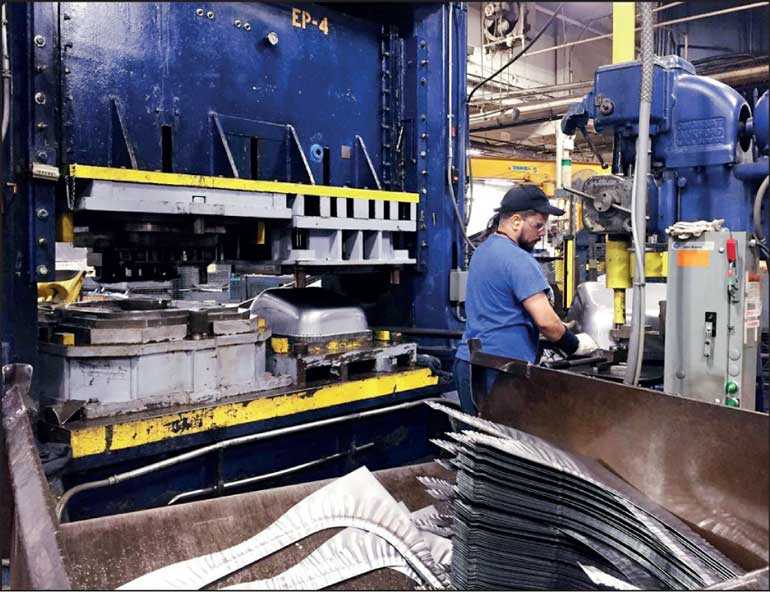Thursday Dec 12, 2024
Thursday Dec 12, 2024
Monday, 22 April 2019 00:00 - - {{hitsCtrl.values.hits}}

A production line employee works at the AMES Companies
factory, the largest wheelbarrow factory in the world, in Harrisburg, Pennsylvania, US on 29 June 2017 - Reuters
Washington (Reuters): The US trade deficit fell to an eight-month low in February as imports from China plunged, temporarily providing a boost to President Donald Trump’s “America First” agenda and economic growth in the first quarter.
The surprise second straight monthly narrowing in the trade gap reported by the Commerce Department on Wednesday was also driven by soaring aircraft exports, which are likely to reverse after Boeing halted deliveries of its troubled 737 MAX aircraft. MAX planes have been grounded indefinitely following two deadly crashes.
Economists warned the trade deficit would remain elevated regardless of whether the United States and China struck a trade deal that was to the White House’s liking because of Americans’ insatiable appetite for cheaper imports.
Talks between Washington and China to resolve the bitter trade war have been dragging. The United States is also embroiled in conflicts with other trading partners, including the European Union, contributing to big swings in exports and imports data in recent months.
“Even if trade negotiations are resolved in such a way as to reduce the bilateral trade deficit with China, one of the Trump administration’s stated goals, this would likely divert trade flows to other countries and have little impact on the top-line US trade deficit,” said Emily Mandel, an economist at Moody’s Analytics in West Chester, Pennsylvania.
The trade deficit tumbled 3.4% to $49.4 billion in February, the lowest level since June 2018. Economists polled by Reuters had forecast the trade shortfall widening to $53.5 billion in February.
The politically sensitive goods trade deficit with China - a focus of the Trump administration’s protectionist trade policy - decreased 28.2% to $24.8 billion in February as imports from the world’s No. 2 economy plunged 20.2%. US exports to China jumped 18.2% in February.
Washington last year imposed tariffs on $250 billion worth of goods imported from China, with Beijing retaliating with duties on $110 billion worth of American products. Trump has defended the duties as necessary to protect domestic manufacturers from what he says is unfair foreign competition.
Trump has delayed tariffs on $200 billion worth of Chinese imports. The White House argues that substantially reducing the trade deficit would lift annual economic growth by at least 3% on a sustainable basis, a feat that economists have said is impossible because of low productivity and population growth.
The economy grew 2.9% in 2018.
The dollar was little changed against a basket of currencies, while US Treasury debt prices rose marginally. Stocks on Wall Street fell.
February’s smaller trade deficit suggests the economy will probably avoid a sharp slowdown in growth that had been feared at the start of the year. The goods trade deficit declined 1.7% to an eight-month low of $72.0 billion in February.
When adjusted for inflation, the overall goods trade deficit fell $1.8 billion to $81.8 billion, also the lowest since last June. Goldman Sachs raised its first quarter gross domestic product estimate by four-tenths of a percentage point to a 2.1% annualised rate.
The Atlanta Federal Reserve bumped up its GDP forecast to a 2.4% pace from a 2.3% rate. The economy grew at a 2.2% rate in the fourth quarter.
“It sounds like pencils are being sharpened in order to revise up first-quarter GDP forecasts,” said Jennifer Lee, a senior economist at BMO Capital Markets in Toronto.
In February, goods exports increased 1.5% to $139.5 billion. The surge in goods exports is unlikely to be sustained given slowing global economic growth. The dollar’s strength last year means US-manufactured goods are less competitive on foreign markets. Shipments of civilian aircraft soared by $2.2 billion in February. Exports of motor vehicles and parts increased by $0.6 billion. There was a small rise in soybean exports. Economists expect soybean exports to remain moderate because of an outbreak of swine flu that has reduced demand for soybean meal in China.
In February, imports rose 0.2% to $259.1 billion. Consumer goods imports increased by $1.6 billion in February, led by a $2.1 billion rise in imports of cellphones and other household goods.
Imports of industrial supplies and materials fell by $1.2 billion. Capital goods imports rose slightly, pointing to slower business spending on equipment.
Crude oil imports fell to 173.7 million barrels, the lowest since March 1992, from 223.1 million barrels in January. An increase in domestic production has seen the United States become less dependent on foreign oil.
“We see more potential for stronger imports in coming months, which would re-establish a trend toward wider deficits,” said Andrew Hollenhorst, an economist at Citigroup in New York.